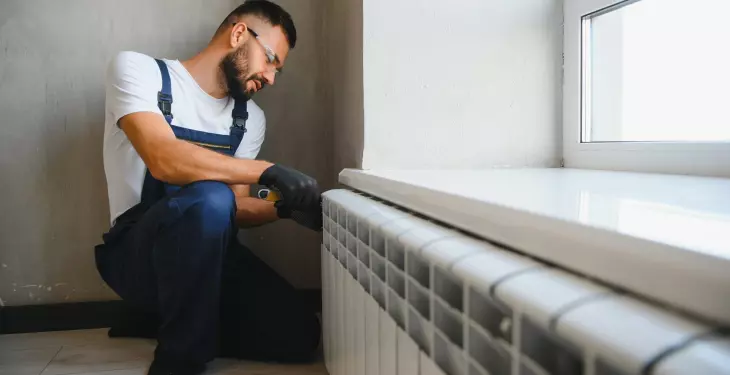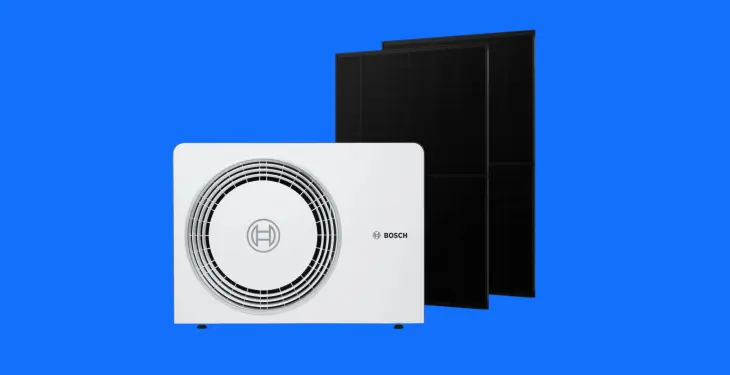

Written by Stephen Day
Gas Safe Engineer
Updated: 1st August, 2025
Heat pump thermostats play a crucial role in managing the temperature in homes. A heat pump can both heat and cool a home by reversing the flow of refrigerant.
See how much you could save with a heat pump quote.
Thermostats play a crucial role in ensuring the efficiency of heat pumps, particularly in the UK climate. These devices aren't just standard controls; they are specially designed to work seamlessly with heat pumps, which operate differently from traditional systems. Selecting the right thermostat can significantly improve your home's heating efficiency while also offering personalised control over your environment.
A heat pump thermostat can be wired or wireless, programmable or smart, with each type offering different features. The technological advancements in thermostats enable homeowners to adjust settings remotely via Wi-Fi, providing convenience and flexibility in managing home temperature. With energy efficiency becoming more important, having a thermostat that suits your specific needs is essential for both environmental and economic benefits.
Compatibility is key when choosing a thermostat for your heat pump. It’s vital to ensure the chosen device can communicate effectively with your heat pump system for optimal performance. Understanding the wiring and installation process will also aid in a successful setup, allowing you to enjoy the benefits of a well-regulated home environment.
Heat pump thermostats play a crucial role in managing the temperature in homes. A heat pump can both heat and cool a home by reversing the flow of refrigerant. The thermostat's primary function is to control this process by sending signals to the heat pump.
The thermostat communicates with the heat pump's reversing valve, which changes the direction the refrigerant flows. This process ensures efficient switching between heating and cooling functions. If the home needs warmth, the thermostat signals the valve to direct the refrigerant for heating. For cooling, it reverses the direction.
Modern thermostats do more than just switch modes. They also monitor indoor humidity and pressure levels to maintain comfort. These devices can adjust cooling and heating settings to optimise the home environment, making sure it is neither too dry nor too humid.
Smart thermostats can enhance efficiency further. They learn user preferences and adjust settings automatically, offering better energy management. This not only maintains comfort but also helps save on energy bills.
For optimal performance, it's essential that the thermostat is compatible with the heat pump system. Choosing the right one ensures that everything runs smoothly. Some thermostats also come with Wi-Fi capability, allowing users to control settings remotely.
In the UK, where heat pumps are gaining popularity, a suitable thermostat contributes greatly to overall energy efficiency. An efficient thermostat is an investment in comfort and cost savings.
Installing a thermostat for your heat pump can greatly enhance your home's energy management. It helps automatically regulate both heating and cooling. This means it adjusts temperatures as needed, without constant manual input.
A specialised thermostat is crucial for heat pumps because it manages the reversing valve. This valve is essential for shifting between heating and cooling. Without the proper thermostat, this process could be inefficient.
Thermostats designed for heat pumps also optimise energy efficiency. By maintaining water temperature in hot water tanks between 40 and 50°C, they ensure the system uses energy more wisely. This not only reduces the energy bill but maintains comfort.
Here are other key benefits:
Convenience: Less manual adjustment needed.
Cost-efficiency: Helps in cutting down on energy expenses.
Comfort: Maintains ideal temperatures throughout the home.
Many modern heat pumps are compatible with smart thermostats. These can be controlled remotely and adjust precicely to daily routines. They further contribute to reducing energy usage and monthly bills.
In summary, a thermostat is a useful addition to manage heating for hot water and energy consumption. With the right one, your home's climate system can become more automated and efficient.
Compatibility
Ensure the thermostat is compatible with your specific heat pump system. Not all thermostats work with every system, so check the specifications carefully.
Programmability
Look for programmable features that allow for custom settings and schedules. This can help in saving energy and maintaining comfortable temperatures.
Wired vs. Wireless
Choose between wired and wireless options. Wired thermostats usually offer a stable connection, while wireless models provide more flexibility in placement.
Ease of Use
User-friendly interfaces with clear displays make operation simple. Thermostats with touchscreens or apps can enhance ease of use.
Energy Efficiency
Energy-saving features, like smart learning functions, help optimise the system's performance and reduce energy bills.
Smart Features
Consider models with smart capabilities, such as remote control via smartphones or integration with home assistants.
Cost
Evaluate the price against the features offered. More advanced models might cost more but can offer better functionality and savings.
Warranty and Support
Check the warranty period and available customer support. This ensures peace of mind in case of any issues.
Installation
Some thermostats require professional installation. Others allow for simple DIY setup. Determine which suits your needs and skills.
Security
For smart thermostats, consider security features to protect against unauthorised access. Regular updates can also enhance security.
Selecting the right thermostat for your heat pump is essential. Each type offers unique benefits and features. Here’s a quick look at the main options available.
Mechanical Thermostats
These are the most basic and cost-effective. They use simple mechanical switches to control temperature. Ideal for those who prefer straightforward operation without advanced features.
Electrical Thermostats
These are more advanced than mechanical versions. They offer more precise temperature control and are often programmable. Users can set different temperatures for varying times of the day. They save energy by ensuring heating happens only when needed.
Smart Thermostats
Highly popular in 2025, these offer the most functionality. Smart thermostats connect to Wi-Fi, allowing remote control through an app. They can learn your habits and adjust settings automatically. This technology can be more energy-efficient.
Remote Sensors
Some thermostats come with remote sensors. These sensors monitor temperature in multiple rooms, ensuring even heating. They are particularly useful in larger homes where one thermostat alone may not provide accurate readings everywhere.
Programmable Room Thermostats
These thermostats offer a blend of programmability and efficiency. Users can schedule temperatures by day and time to optimise comfort and energy savings. Some models also provide energy usage reports, helping households reduce their carbon footprint.
Choosing the right thermostat depends on specific needs and budget. Whether prioritising simple controls or advanced automation, there’s an option to match every preference.
1. Check for Compatibility Features:
When choosing a thermostat, ensure it is specifically designed for heat pumps. Some thermostats, like the VRC 700, are built to handle the unique needs of these systems.
2. Look for Special Modes:
A good thermostat for heat pumps should have an auxiliary or emergency heat mode. This feature activates when the heat pump alone can't heat the home efficiently.
3. Programmable Options:
Many modern thermostats offer programmability. This feature allows users to set different temperatures for different times of the day. Make sure the chosen thermostat includes this capability for optimal energy savings.
4. Wiring Requirements:
Check the wiring in your home and ensure that it matches the thermostat's requirements. Heat pump thermostats often require more connections than standard models.
5. Energy Performance:
Energy-efficient thermostats help maximise the performance of your heat pump. Look for models with good energy ratings or smart features that adjust based on your habits.
6. Consult With Professionals:
If unsure, consulting with a professional can help avoid compatibility issues. They can provide guidance on the best models for your specific heat pump system.
Proper consideration of these points will ensure users select the right thermostat for their heat pump, enhancing both comfort and efficiency.
Installing a thermostat for a heat pump requires care and precision. Wiring is a critical aspect.
Wired vs Wireless: Some thermostats, like the wired VRC 700, connect directly to the heat pump. This ensures stable communication but might need more time to install. Wireless options, such as the VRC 700f, offer greater flexibility. These are easier to place anywhere in the house but rely on a strong signal.
Steps for Installation:
Turn Off Power: Always switch off the power to the heat pump before beginning work to ensure safety.
Identify the Wires: Thermostats usually have several wires. Understand each colour's purpose by checking the manual for specifics.
Connect Correctly: Attach each wire to its respective terminal. A mismatch can cause the thermostat to malfunction.
Secure the Thermostat: Mount it in a central location, away from direct sunlight and drafts for accurate readings.
Consider Charge Levels: For wireless thermostats, maintaining a full charge is essential. Regularly check the charge to avoid unexpected shutdowns.
Benefits of Programmable Thermostats: Modern thermostats often offer programmability, allowing users to set different temperatures for various times of the day. This feature enhances efficiency and comfort, aligning with the UK's energy-saving goals.
Programmable thermostats offer a handy way to manage home heating. They let users set different temperatures for various times of the day. This flexibility means that energy is used more efficiently, helping to reduce energy bills. Users can programme the system to warm up before they wake up or cool down when they are away.
Heating control is vital for comfort and energy savings. These thermostats allow for multiple room settings, ensuring each space has the ideal temperature. This feature is especially useful in larger homes, where heating needs vary from room to room. It also enables users to create personalised schedules for optimal comfort throughout the house.
Frost protection is another valuable feature. Some programmable thermostats automatically activate heating if the temperature drops too low, preventing pipes from freezing. This function helps maintain a consistent environment within the home, which is particularly important during the colder months.
Some models can be controlled remotely through mobile apps, allowing for adjustments on the go. Whether users are at work or on holiday, they can ensure their home’s climate is just right upon return.
These thermostats are compatible with various heating systems, including heat pumps. The integration with heat pumps ensures efficient heating management and optimal performance. By tailoring the heating schedule, users maximise the energy efficiency of their home systems.
Wi-Fi enabled thermostats are revolutionising the way homeowners interact with their heating systems. These smart devices allow control over a heat pump from virtually anywhere, provided there is an internet connection. This convenience is perfect for those who travel frequently or have unpredictable schedules.
Smart Thermostats are gaining popularity for their ease of use and energy-saving potential. Models like the Nest Learning Thermostat can learn users' habits and adjust temperatures accordingly. This not only ensures comfort but also optimises energy efficiency.
With integration capabilities, these thermostats can be paired with Amazon Alexa or Google Assistant. This allows users to control their heating using voice commands, adding another layer of convenience. For example, adjusting the temperature while hands are full becomes as easy as speaking a command.
Many Wi-Fi enabled thermostats feature geofencing. This function detects when a homeowner is close to or away from home, adjusting the heat pump settings automatically. This ensures a warm welcome without wasting energy.
Key Features of Wi-Fi Enabled Thermostats:
Remote Access: Control settings from smartphones, tablets, or computers.
Voice Control: Compatible with Amazon Alexa and Google Assistant.
Energy Monitoring: Track and optimise energy usage reports.
Adaptive Learning: Some models learn habit patterns for efficiency.
Geofencing: Adjusts settings based on location.
These thermostats are particularly valuable in places like the UK, where weather can be unpredictable. Being able to adjust settings remotely ensures homes remain comfortable amidst changing climate conditions.
When selecting a thermostat for a heat pump, design is key. A sleek and modern look can complement the interior design of a home. Thermostats come in various styles to match different aesthetics. Choosing the right design can make the device blend seamlessly with the decor.
Display Options
A backlit display is essential for visibility in dimly lit rooms. It makes reading the temperature and settings easy at any time of day or night. Many modern thermostats feature touchscreens, which add a touch of elegance and ease of use.
Wall-Mounted or Freestanding
Some thermostats are mounted on the wall, while others can be placed on a stand. Wall-mounted units save space and are more common. Freestanding models offer flexibility as they can be moved to different rooms if needed.
Smart Features
Smart thermostats can connect to other smart home devices. This integration allows users to control the home's temperature remotely. Some models may also offer additional features like energy usage reports.
Material and Colour
Thermostats are available in various materials and colours. Choose a colour that matches or complements wall paint or other home fixtures. Materials can vary from durable plastics to metal finishes, each adding a different aesthetic appeal.
Incorporating these design elements ensures the thermostat is both functional and visually pleasing in the home.
Thermostats for heat pumps in the UK vary in price based on factors like smart features and brand reputation. Basic models typically start around £20 to £50. These are ideal for users seeking simple temperature control without advanced features.
Smart thermostats, like those from Nest or Hive, offer more functionality, such as remote access via apps and automated scheduling. Prices for these can range from £100 to £250. These devices come with energy-saving capabilities, which can potentially reduce heating costs.
ErP Class ratings can influence prices. Thermostats with higher efficiency ratings may initially cost more, but users often recoup these expenses through energy savings.
Some models require additional equipment, such as a hub for smart features. Installation costs also vary. Simple models may be DIY-friendly. Smart systems might require professional setups, adding to the overall expense.
When purchasing a heat pump thermostat in the UK, it is important to understand the warranty coverage offered. Most manufacturers provide warranties for thermostats, similar to those for the heat pumps themselves, but the details can vary.
Typical Warranty Periods
Standard Warranties: Typically range from 1 to 5 years.
Extended Warranties: Some brands offer extended coverage if the thermostat is registered after installation.
Coverage Details
Warranties usually cover manufacturing defects and faults. They may not extend to issues arising from improper installation or misuse. Hence, it's vital to follow the manufacturer's guidelines for installation and use.
Maintaining Validity
For many thermostats, the warranty remains valid only if used with compatible systems. Regular maintenance and prompt reporting of any issues will help in retaining warranty benefits. Regular check-ups ensure the thermostat functions efficiently and maintain warranty terms.
Manufacturer Support
Most brands offer dedicated support for troubleshooting and repairs. Contacting the manufacturer directly is often the best way to resolve any covered faults. This support can be invaluable in keeping the system running smoothly.
Last updated: 1st August, 2025

Written by Stephen Day
Gas Safe Engineer at iHeat
Stephen Day is a Gas Safe registered and FGAS certified engineer with over 20 years of hands-on experience in the heating, cooling, and renewable energy industry, specialising in boiler installations, air conditioning, and heat pump systems.
LinkedInArticles by Stephen Day are reviewed by iHeat’s technical team to ensure accuracy and reliability.

05th December, 2025
Most homes need some radiators upgraded for a heat pump, but usually not all of them.
 Read Article
Read Article

05th December, 2025
Most homes can lower heating costs by combining air source heat pumps with solar panels.
 Read Article
Read Article

28th November, 2025
High temperature heat pumps work like boilers without needing radiators, but they cost mor...
 Read Article
Read Article
No obligation. Takes less than 60 seconds.